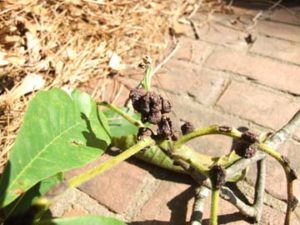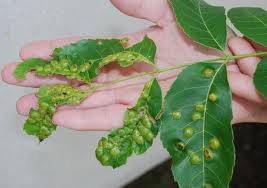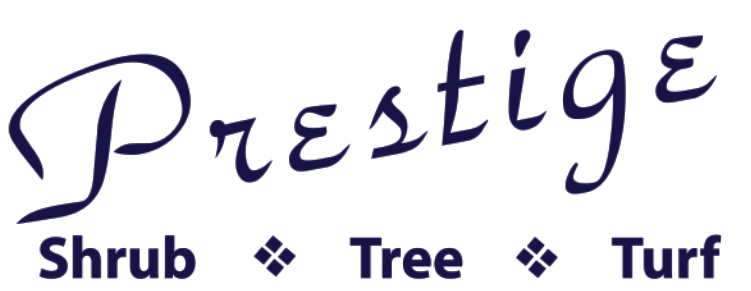 This is a fairly common gall that is seen each year. Phylloxeragall on hickory (seen here) exhibits as small galls on the stems and leaves of the tree. Though this gall can cause severe deformation of the leaves and stems resulting in sometimes severe defoliation it does not cause permanent damage to the trees.
This is a fairly common gall that is seen each year. Phylloxeragall on hickory (seen here) exhibits as small galls on the stems and leaves of the tree. Though this gall can cause severe deformation of the leaves and stems resulting in sometimes severe defoliation it does not cause permanent damage to the trees.
Pecan trees sometimes develop round galls one-fourth to 1 inch in diameter on twigs and leaves in late April, May and early June. The galls are the result of the feeding of very small insects called pecan phylloxera in April.
The galls generally split open in late May and early June and release small, greenish, winged aphid-like insects. The galls then dry, which causes twig dieback and leaf drop. Severe infestations of this insect can cause loss of the pecan crop for the current year and also for the following year. Foliar sprays are usually not cost effective in home situations. These trees can be treated with Imidacloprid during March or April but many times control results will not be seen until the following year.
 It is essential that you read the complete label of any insecticide you decide to use. Since these nuts are edible, only certain insecticides (this includes all pesticides) may be used on the trees. Many pesticides cannot be used while other may have restrictions as to how many days after application of the pesticide the nut can be harvested . If you need help with these labels call the manufacturer or your county agent. Remember though, this pest does not need to be treated.
It is essential that you read the complete label of any insecticide you decide to use. Since these nuts are edible, only certain insecticides (this includes all pesticides) may be used on the trees. Many pesticides cannot be used while other may have restrictions as to how many days after application of the pesticide the nut can be harvested . If you need help with these labels call the manufacturer or your county agent. Remember though, this pest does not need to be treated.
Here you can see the gall on a pecan leaf.
« Back to Glossary Index